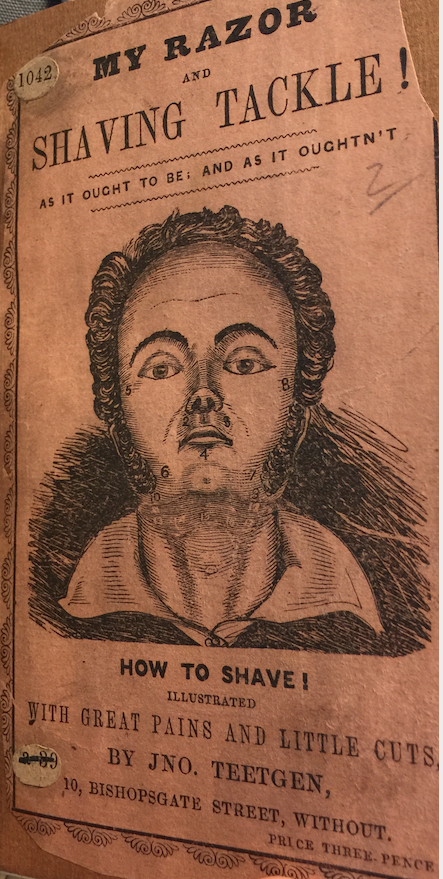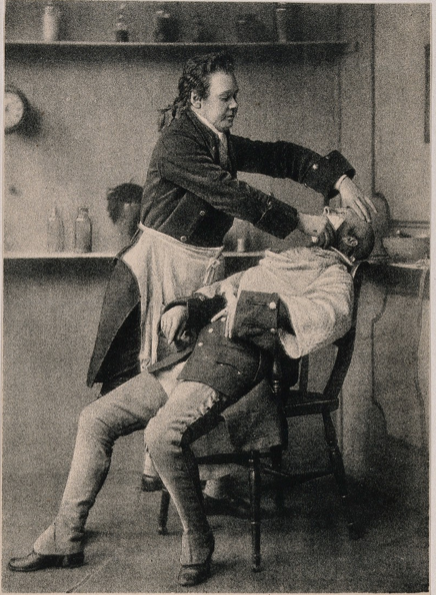One of the central themes of my new book is how the practice of shaving has changed over time and, more importantly, who has been responsible for it. From the second half of the eighteenth century, individual men began to take more responsibility for shaving themselves, helped on by the availability of newer, sharper steel razors. Being able to shave yourself or (if you were wealthy enough) having a servant to do it for you, was a mark of status.
But throughout the early modern period, and indeed through the eighteenth century and into the nineteenth, it was still the barber who was the main provider of shaving for the vast majority of men. A couple of things that I have long wondered about as I worked on my project was how much a visit to the barber cost in the seventeenth and eighteenth centuries and how frequently men went for a shave.
The second part of the question is easier to answer than the first. Passing references in diaries do sometimes mention when men visited a barber although, because it was a routine occurrence, they didn’t usually give much detail…unless, of course, something went wrong! Samuel Pepys, for example, often noted in his diary when he was trimmed or shaved by his barber, Jervis. But establishing how much individual men paid, and for what, is more difficult since this wasn’t generally noted. Since barbers were very often small businesses too, they seldom left details of their charges in the historical record, especially in this period.
One type of source – household accounts – does provide useful clues not only about how much (admittedly middling and elite) men paid for a shave, but how often they went to their barber. Even here, though, matters are complicated by the terminology used surrounding the practices of the barber. Often, men referred to being ‘trimmed’ by the barber. This could refer to shaving, but it could also refer to a haircut. Equally, the word ‘shaved’ is problematic, because it might refer to shaving the face or the head. Even a generic entry such as ‘paid the barber’ masks what was actually done.
Also problematic is the habit of paying barbers on account, rather than in cash on the day. Some men simply paid a blanket sum either quarterly or sometimes annually. In 1717, for example, Thomas Milward, a Stourbridge attorney paid ‘Mr Hopkins the barber [for] 1 yrs shaving and powdring me’, but the number or frequency of visits covered by this sum is unknown, as is whether ‘shaving’ referred to the head, face, or both. But, even despite these limitations, it is still possible to make some educated guesses!
One thing that is clear is how important a figure was the barber to early modern men. Barbers took responsibility for a wide range of bodily tasks, from shaving and haircutting to digging out earwax, scraping tongues, lancing boils and any number of other minor running repairs. Barber’s shops were hugely important spaces for men to gather, gossip, eat and drink, and also sometimes to play music. Some barbershops even had their own instruments for customers to use whilst they waited. So it is firstly important to note that visiting the barber’s shop might not necessarily always been to have something ‘done’, but instead just to hang out with other male friends.

Having gone through lots of entries across many different sets of accounts though, some patterns do begin to emerge. Most common, it seems, at least for wealthier men, was to visit a barber either once or twice a week to be shaved. Given the preference for the clean-shaven face from the late seventeenth century, this likely meant having the stubble scythed off, but might also include the head, to accommodate a fashionable wig. In 17th-Century Westminster, the barber John Phillips noted that he shaved John Powell up to three times a week…sometimes washing his feet and cutting his corns into the bargain.
For men lower down the social scale, however, a single weekly shave (referred to as a ‘hebdomadal shave’!) was more likely. In these cases, we can also pinpoint the day, which was almost always a Saturday, due to the need to This was because of the social importance of appearing decent in church on Sunday mornings.
Adding together the evidence from lots of different accounts also starts to give a picture of how much men paid for the services of the barber. Costs could vary according to where you lived, your social status, and where the shave took place. A mark of wealth was having a barber attend you at your own home, rather than sit amongst the proles in a grubby shop. This possibly carried a higher charge because of the inconvenience and extra cost to the barber, although it also meant that some barbers (known as ‘flying barbers’) could dispense with running a shop altogether.
In shops, costs also varied widely, from a penny to as much as a shilling, and even sometimes more. Some accounts note instances where haircutting was included with shaving, incurring a higher cost, which allows some direct comparison. Overall, the most common charge occurring across many different accounts for shaving was sixpence each time. When men paid quarterly for barbering services, they usually paid between three and seven shillings, again depending on circumstances.
This last point also highlights the issue of status. A common feature of barbers was the tailoring of prices according to the means of their customer. Barbers serving poorer punters charged less, by necessity. But, ministering to the podgy faces of elites offered the chance for greater fees. The issue of charges also lets us address the long-held assumption that barbers were low status practitioners. Even if a barber charged only sixpence for a shave, and carried out 20 shaves a day for 300 days a year, it was entirely possible, depending on profit margins, to make around £75 per year, representing a solid, middling income.
So perhaps we need to rethink the whole issue of barbers and status. For a long time they were regarded (and often depicted) unfairly as low-rank chatterers, who scraped the faces of the poor for a few pennies. In fact, barbers were – and in fact still are – key practitioners for men, not only in terms of fashioning heads and faces but, in providing important social spaces for men.














































